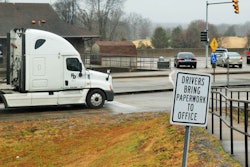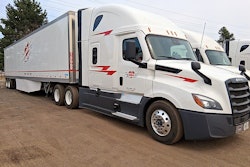The U.S. Department of Transportation last week announced 52 deregulatory actions across three agencies -- including the Federal Motor Carrier Safety Administration -- that rescind and amend regulations that the DOT called “burdensome regulations that do not enhance safety.”
As reported last week, FMCSA is taking 20 actions, including two final rules that took effect Friday, May 30, and 18 proposals now open for public comment though July 29.
The two final rules, which you can read more about here, were the repeal of for-hire motor carrier routing regulations and amending the civil penalties schedule to remove redundant language. Among the 18 proposals, eight propose to rescind existing regulations and 10 offer amendments to regulations.
The proposals come following an open comment period the FMCSA conducted collecting feedback from industry stakeholders who identified numerous areas of potential priority for the agency. Prior reporting found four major areas of regulation, among others, most prevalent in those comments recommending modification and/or rollback: Hours of service/electronic logging device regulations, FMCSA's pursuit of a speed-limiter mandate, FMCSA's broker transparency rulemaking initiated late last year, and the joint DOT agency efforts around requiring automatic emergency braking technology.
Among the rules the agency is proposing to rescind, just one pertained to any of the four broad areas identified in stakeholder public comments: removal of the requirement that truck drivers keep their ELD’s user’s manual in the truck. Some of the proposed changes did directly respond to industry input in other areas.
In announcing the deregulatory efforts, the DOT said the efforts outlined here follow executive orders from President Trump calling for deregulatory action. The DOT did not indicate whether more deregulation is on the horizon within its agencies.
[Related: FMCSA repeals old carrier route regs]
The eight rules FMCSA is proposing to rescind are:
- Requirement for ELD operator’s manual located in CMV: FMCSA proposes to rescind the in-vehicle electronic logging device (ELD) operator’s manual requirement. FMCSA currently maintains a list of the ELD vendors who have self-certified their products, including submission of the operator’s manual. Additionally, drivers are required to understand the operation of the ELD on the vehicle. FMCSA said there is no readily apparent benefit to continuing to require that the user's manual be in the truck. Comments can be filed here.
- Self-reporting requirement: FMCSA proposes to revise its regulations requiring CDL holders to self-report motor vehicle violations to their state of domicile. With the implementation of the exclusive electronic exchange of violations between state drivers licensing agencies (SDLAs) in 2024, self-reporting is no longer necessary. Comments can be filed here.
- Spare fuses: FMCSA proposes to remove the requirement for commercial motor vehicles (CMVs) to be equipped with at least one spare fuse for each type and size of fuse needed for the parts and accessories of the CMV. This proposed change would remove an unnecessary requirement from the FMCSRs, the agency said. Comments can be filed here.
- Certification and labeling requirements for rear impact protection guards: FMCSA is proposing to rescind the requirement in the motor carrier regulations that the rear impact guard be permanently marked or labeled with a certification from the impact guard manufacturer, as required by the National Highway Traffic Safety Administration’s (NHTSA) applicable Federal Motor Vehicle Safety Standard (FMVSS). The certification label or marking provides motor carriers purchasing new trailers or new impact guards to replace damaged devices with a means to determine whether the equipment is certified as meeting the FMVSS. However, the labeling or marking requirement has proven problematic for motor carriers when it's no longer legible or completely wears off during the life of the trailer or guard. This proposal would eliminate an unintended regulatory burden on motor carriers without compromising safety, FMCSA said, as this NPRM doesn't affect the applicable FMVSS. The proposal would also rescind a guidance document pertaining to illegible, incomplete, or missing rear impact guard certification labels. Comments on the proposal can be filed here.
- Retroreflective sheeting on semitrailers and trailers: This proposal would rescind the requirements for retroreflective sheeting on semitrailers and trailers manufactured prior to December 1, 1993, which is the compliance date for the NHTSA conspicuity rules applicable to trailer manufacturers. The retrofitting requirements were adopted by the Federal Highway Administration (FHWA) on March 31, 1999, and require that motor carriers engaged in interstate commerce install retroreflective tape or reflex reflectors on the sides and rear of semitrailers and trailers that were manufactured prior to December 1, 1993, have an overall width of 2,032 mm (80 inches) or more, and a gross vehicle weight rating of 4,536 kg (10,001 pounds) or more. With the passage of more than 30 years since the NHTSA requirements were implemented, FMCSA believes the vast majority of trailers currently in use were manufactured after 1993, making the retrofit rule no longer necessary. The proposal would eliminate obsolete regulatory text without compromising safety, FMCSA said. Comments can be filed here.
- Liquid-burning flares: FMCSA is proposing to remove references to liquid-burning flares from the warning device requirements in the FMCSRs. The agency said the proposed revision would remove outdated language referring to warning devices that FMCSA believes are no longer used. Comments can be filed here.
- Removal of obsolete references to “water carriers”: This proposal would remove all obsolete references to “water carriers” in the FMCSA regulations. FMCSA said it does not specifically regulate water carriers except to the extent that such carriers also engage in motor carrier operations. In such cases, the existing FMCSRs provide appropriate coverage of the carrier’s motor carrier operations. The term is used in several sections of the FMCSRs and was carried over from FMCSA’s predecessor agencies. Comments can be filed here.
- Vision standards grandfathering provision: FMCSA proposes to amend its regulations to remove the grandfathering provision under the physical qualifications standards for interstate drivers operating under the previously administered vision waiver study program -- the provision is now obsolete, the agency said. The waiver study program was terminated prior to the adoption of rules in 1998 implementing the Transportation Equity Act for the 21st Century provision concerning waivers, exemptions and pilot programs. A 2022 rule that amended vision regulations eliminated the need for both the vision exemption program that then existed and the grandfather provision for drivers operating under the old wavier program. The grandfathering provision remained in effect until March 22, 2023, and after that, all drivers were required meet the new alternative vision standard. Comments can be filed here.
[Related: Hours of service should be front and center in DOT deregulatory effort: Truckers]
The agency is also proposing to amend 10 existing regulations, including railroad grade crossing stopping requirements, Daily Vehicle Inspection Report requirements and more. The proposed revisions are:
- Exception for railroad grade crossing equipped with active warning device not in activated state: FMCSA proposes to amend the regulations related to driving at railroad grade crossings. Currently, drivers of certain commercial vehicles -- buses transporting passengers, trucks hauling certain hazardous materials -- are required to stop before crossing a railroad track unless an exception applies, such as when the railroad grade crossing is controlled by a functioning highway traffic signal transmitting a green indication. The agency is proposing to add a similar exception for a railroad grade crossing equipped with an active warning device that is not in an activated state -- such as flashing lights or crossing gates down, indicating the arrival of a train -- provided that the driver has exercised due caution to ascertain that the course is clear before crossing and local law permits the vehicle to proceed across the tracks without stopping. FMCSA is accepting comments on this proposal, as well as whether § 392.11 Railroad grade crossings; slowing down required could be eliminated to further streamline regulations without impacting safety.
- Electronic Driver Vehicle Inspection Reports (DVIRs): This proposal would clarify the requirement to complete a DVIR, based upon a public comment filed by the National Tank Truck Carriers (NTTC). The DVIR may already be completed electronically, however this proposal would add explicit language to make this clear. FMCSA believes this will encourage motor carriers and drivers to utilize electronic, cost-saving methods when completing DVIRs. Comments can be filed here.
- Driver Vehicle Examination Report disposition update: FMCSA proposes to revise the requirement that motor carriers and intermodal equipment providers sign and return a completed roadside inspection form to the issuing state agency. FMCSA said it’s aware that not all issuing state agencies require the return of these reports. Also: Requiring carriers and intermodal equipment providers to submit the reports to a state that does not require, or even request, the return of the form creates an unnecessary burden. Through this proposed change, completed forms need only be returned to those states that request them. The action is in response to a petition for rulemaking from the Commercial Vehicle Safety Alliance (CVSA). Comments can be filed here.
- Fuel tank overfill restriction: This proposal would remove the requirement in the motor carrier regs that a liquid fuel tank manufactured on or after January 1, 1973, be designed and constructed so that it cannot be filled, in a normal filling operation, with a quantity of fuel that exceeds 95% of the tank’s liquid capacity. This proposal is in response to a petition for rulemaking from the CVSA. In its request, CVSA noted that liquid fuel tanks are now manufactured with a vented cap, which allow 100% fill, based on the positioning of the filler neck and vented cap, with no resulting issues. The proposed change would remove an unnecessary and outdated requirement from the FMCSRs, the agency said. Comments can be filed here.
- CDL standards; Requirements and penalties -- Applicability to the exception for certain military personnel: This revision to the regulations would allow dual-status military technicians to qualify for the exception for certain military personnel from the commercial driver license (CDL) standards in part 383 of the FMCSRs. The regulations currently do not allow U.S. Reserve technicians to qualify for the exemption. This rule responds to a petition for rulemaking submitted by James D. Welch, who said the current regulation places an unfair burden on career U.S. Air Force Reserve Technicians, who are required to wear the military uniform in the same manner as National Guard Military Technicians but are not similarly authorized to utilize the CDL exemption. Comments can be filed here.
- Brakes on portable conveyors: This proposal would add an exception for portable conveyors used in aggregate industry operations and manufactured before 2010 from the requirements that each CMV be equipped with brakes acting on all wheels, provided certain conditions are satisfied. This proposal is in response to a petition for rulemaking from the Michigan Aggregates Association (MAA). MAA stated that, prior to 2010, portable conveyors were not manufactured with brakes because the drum brakes used at the time would trap sand, rocks and other materials found in aggregate pits, which would render the brakes useless. The proposed change would provide relief from a regulatory requirement for certain portable conveyors without impacting safety. Comments on the proposal can be filed here.
- Auxiliary fuel tanks: FMCSA proposes to add an exception to the prohibition on gravity and syphon feeds for auxiliary pumps with a fuel tank capacity of less than five gallons mounted on the trailer chassis frame or trailer bed, for purposes other than operation of the motor vehicle (operational only when the vehicle is not in motion). This proposal is in response to a petition for rulemaking from the Truck Trailer Manufacturers Association (TTMA). TTMA said carriers were modifying their trailers in some cases to accommodate a gasoline-powered auxiliary pump for use other than powering the CMVs. To comply with the prohibition on gravity or syphon feeds, carriers will often modify the trailer by installing a fuel tank with a fuel pump along with associated top mountings and fuel lines separately to operate the auxiliary pump, the group said. TTMA expressed concern regarding the structural integrity of the fuel tank attachments and the prohibitive costs associated with making such modifications for the sole purpose of compliance. Comments can be filed here.
- Accident reporting -- Modification to the definition of the term “Medical Treatment": FMCSA proposes to revise the term "medical treatment" in the regulations for the purpose of accident reporting, to incorporate revised regulatory guidance regarding medical treatment away from the accident scene. In FMCSA’s regulations that define an “accident,” there is no explanation of what constitutes “medical treatment.” In 2022, FMCSA revised guidance to clarify that medical treatment did not include diagnostic procedures, such as x-ray or CT. This proposal would incorporate that guidance into the definition of “accident.” A new paragraph would be added to the definition to clarify that medical treatment does not include x-rays or other imaging, such as CT, and a person who does not receive treatment for diagnosed injuries or other medical intervention directly related to the accident has not received “medical treatment.” Comments on the proposal can be filed here.
- License plate lamps: FMCSA proposes to provide an exception from the lamp and reflective device requirements for license plate lamps on the rear of truck tractors while towing a trailer. The agency said that trucks pulling a trailer do not have a visible license plate on the tractor itself, as the plate would be blocked by the trailer. Comments can be filed here.
- Tire load markings: This proposal would revise the requirements for tires on commercial vehicles to clarify that regulations do not require tire load restriction markings on their sidewalls. This change would eliminate confusion and clarify the scope of FMCSA’s authority regarding the requirements for tires in the FMCSRs, the agency said. FMCSA added that regulated entities have mistakenly believed that § 393.75(g) and (h) require sidewall markings, and that markings missing from the sidewall would be a violation of those requirements. These provisions actually require that motor vehicles and manufactured homes are not operated with a weight in excess of the load limits on the sidewalls of the tires, or, for manufactured homes built before January 1, 2002, with a weight more than 18% over the load limits. A new proposed paragraph would clarify that FMCSA does not require tire markings and avoid any further confusion about the scope and requirements of paragraphs (g) and (h). Comments on the proposal can be filed here.
[Related: FMCSA Chief Counsel on deregulating trucking, English proficiency and non-domiciled CDLs]













